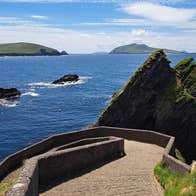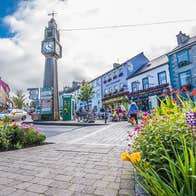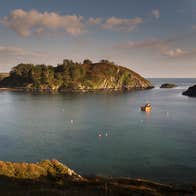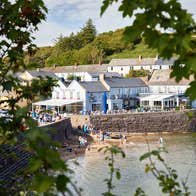Set sail for the Great Blasket island
There are several operators running trips out to An Blascaod Mór (Blasket Islands), some of which run from nearby Cé Dhún Chaoin (Dunquin Pier) or Ceann Trá (Ventry). But the easiest option is a day trip that departs right from the middle of Dingle and incorporates both a landing on the Great Blasket and a wildlife-spotting tour around the nearby coast.
The Premium Day Tour with the Great Blasket Island Experience (6.5 hours, twice daily) is one such trip, departing from Cuan an Daingin (Dingle Harbour) at 9am or 11am. You’ll meet by the statue of the legendary Fungie the Dingle Dolphin, where there’s also a handy water-filling station and public toilets, before setting out through the peaceful harbour on a 50-minute crossing. Along the way, you’ll pass by the base of the dramatic sea cliffs just outside Dingle, getting an up-close look at the rock formations that started 300 million years ago. A tour guide on board points out interesting geological features – these hills and mountains are older than both the Alps and the Himalayas.
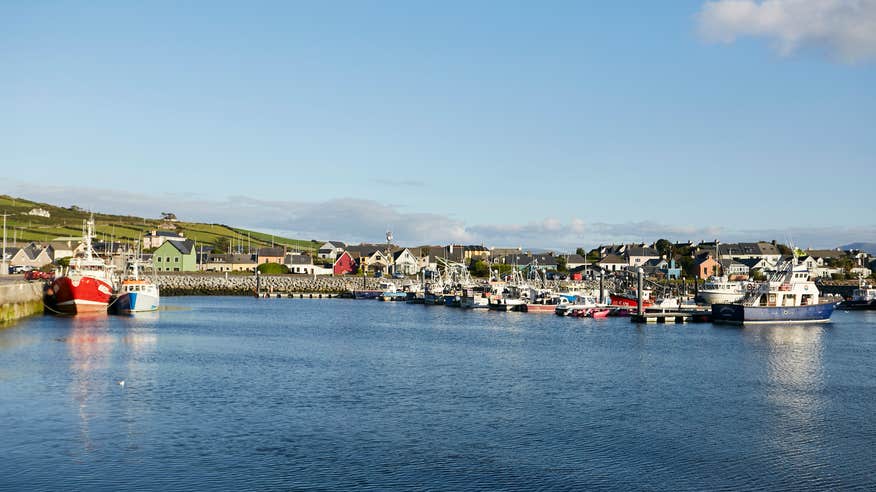
Before the boat lands on the Great Blasket, you’ll pass by the gleaming white sands of An Trá Bán to see the resident colony of seals, whether they’re lounging on the beach or dipping and diving in the waves, popping their heads up to look curiously at the boat. After a quick transfer, a smaller RIB takes you on the final stretch to the island’s sheltered landing spot, where you’ll climb the old, timeworn stone steps up to the abandoned village.
There are OPW guides who lead free tours on the hour, and it’s best to start with one, if the timings align. That way, you’ll get your bearings and learn about the island’s history before you set off to explore it on your own.
As a mainstay of the older Irish Leaving Cert syllabus, many know the name Peig Sayers (and some audibly sigh when her name is mentioned on the tour). But as the guides point out, she’s a pivotal part of the Great Blasket story, and her book is well worth revisiting. On the tour, you’ll see her original home, as well as the house she later lived in (which is now available for off-grid overnight stays).

But Peig wasn’t the only literary resident of the island. Known for their storytelling, this self-sufficient community would gather to share stories every evening around a fire, before the last residents moved to the mainland in 1953, to live in less harsh conditions. There are over 50 books that have been published from islanders, but the best known are Peig, Muiris Ó Súilleabháin and Tomás Ó Criomhthain, and you’ll see what remains of all three of their houses on the tour. Some, like Muiris’s, are now ruins, with clumps of wildflowers growing from the old stone. But Tomás Ó Criomhthain’s home was restored in 2018, and you can walk inside the whitewashed building to see what it would have looked like when he lived there, the floor polished with sand from the beach and a cast iron kettle in the hearth.
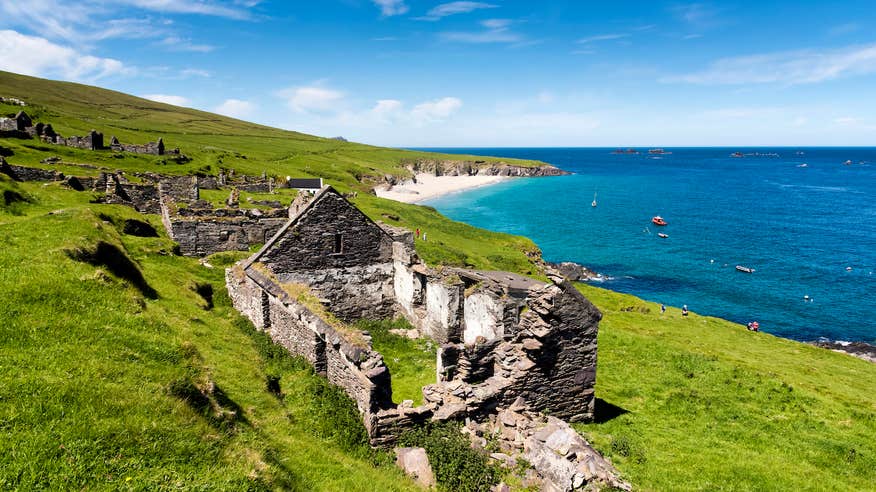
When the tour is over, set off to hike the looped walk that rises up behind the old stone cottages and weaves around the headland. The route takes about an hour and a half to complete, and includes a fair climb – walk clockwise to get the steep bit over and done with at the start. And don’t worry – those burning thighs will be worth it when you get to the top.
The well-trodden trail cuts around the middle of the biggest peaks, giving you exceptional views down over the sloping, bright green grass and out over the sea. Bring a pair of binoculars with you, because you can often spot whales and dolphins in the waters below – a good rule of thumb is to look for the whale watching boats, which will stop when they see a good sighting. But there’s other wildlife on the island too, from the straggly sheep to the rabbits and hares hopping around the heather and wildflowers.

The trail is easy to follow, but keep an eye out for the turning to the right about an hour into the walk – if you keep going straight, you’ll find yourself on a much longer climb, which is tricky to complete within the 3.5 hours you’re on the island (and you don’t want to miss the boat back to mainland).
When the village is back in sight, you’ll come across a scenic bench with beautiful views out over the uninhabited Beiginis island and back to the mainland. If you’ve managed to resist eating it so far, it’s a great spot to tuck into your picnic.
Where to get a picnic in Dingle
While there is a small shop on the Great Blasket, where you can buy drinks and snacks, you’ll need to bring your own lunch to the island. Luckily, there are several spots in Dingle where you can stock up before you get the boat. Bean in Dingle opens at 8am, which is handy if you’re on the 9am sailing, and they sell pre-made sandwiches like a spicy BLT, cheddar and Waldorf salad or coronation chicken, as well as excellent coffee and treats like cruffins and cinnamon rolls.

Photo credit: @beanindingle
An Cupán Tae is right by the harbour and sells paninis and slices of cake, and My Boy Blue has ham and cheese stuffed croissants and homemade sausages rolls, along with freshly made toasties (if you can wait until you’re on the island to eat them, of course). But for a really great picnic, head to The Little Cheese Shop and stock up on brie, Gubbeen and sheep’s cheese. They sell artisan crackers, but you can also pop into Bácús bakery in the local Supervalu for freshly-made sourdough or baguettes. Just remember that the Great Blasket is a Leave No Trace island, so be sure to bring all your rubbish back with you.
Explore the islands from the water
Before you leave the island, follow the trail down to An Trá Bán to get a closer look at the seals, but do keep a respectful distance of at least 100 metres. As the signs say: “Tá coileáin róin ar an dtrá – níl sé ceadaithe cur isteach ortu in aol slí!” (There are seal pups on the beach – it is not permitted to interfere with them in any way!)
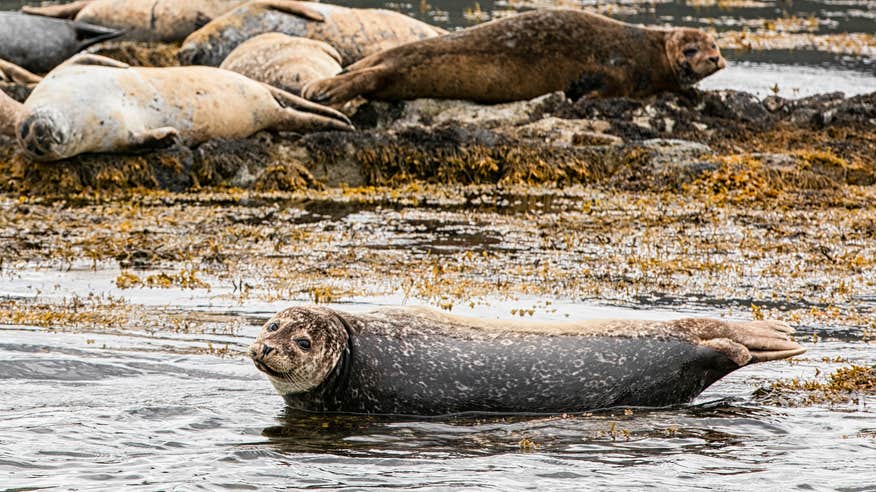
When it’s time to get back on the boat, make your way back to the landing dock. However, the adventure isn’t over – instead of going straight back to Dingle, the boat follows the coastline of the Great Blasket (so you can see how high you climbed on your hike), before heading out to the other islands.
The first one you’ll see is Inis na Bró, a dramatically craggy island with shards of dark rock poking skyward like Superman’s Fortress of Solitude. Depending on the swell, you should be able to get up close to the remarkably angular arches and caves, where the waves crash beneath the rocks and the jagged, spooky outcrops. If you can, sit on the right-hand side of the boat for the best views (which are even better if you sit outside).
If you’re there between late March and late July, you’ll likely spot puffins bobbing around the southern edge of the island and its neighbour, Inis Mhic Aoibhleáin (also known as Charlie Haughey’s island). Keep your eyes peeled on the latter and you might even see some of the native red deer, which he introduced to the island back in 1980.

But the more exciting sightings are in the water, where you could spot dolphins, minke whales, humpbacks and even orcas, if you’re lucky. The route back to Dingle depends on what the skipper can spy in the sea, with everyone on board scanning the horizon for telltale spouts of water shooting up from the surface. Top tip – a flurry of seabirds over the water usually indicates some marine activity below.
After a few hours of wildlife spotting, you’ll return to the same slip in the Dingle Marina, so you can explore the town and pop into some of the local shops. Lily Mais is right on the water, on the pier opposite the Dingle Oceanworld Aquarium. Here, owner Frances Fogarty repurposes towels thrown out by hotels and turns them into brightly-coloured dry robes, dresses and shorts – you can see her at work in the studio onsite, too.
Up on Green Street, Lisbeth Mulcahy Fíodóir is a weaver’s shop where you can pick up kitten soft herringbone scarves, all of which are made upstairs (you can go up yourself and see the loom). And if you’re popping into Dick Mack’s for a pint, you can also pick up a handmade leather belt made to order right behind the bar.

Photo credit: @dickmackspub
Where to eat dinner in Dingle
There is no shortage of great restaurants in Dingle, and the seafood game is particularly strong. One of the local favourites is The Fish Box, a nautically-themed spot with rope woven around the windows and koi wallpaper in the bathrooms. They don’t take reservations, but if they’re busy you can put your name down and nip next door to Dick Mack’s for a drink while you wait for a table. The seafood on offer comes from their very own boat, and while they do excellent fish tacos and crispy chilli monkfish, their fish and chips are some of the best around, the haddock encased in a golden, crisp batter with a generous pot of homemade tartare sauce on the side. If you’d prefer, they have a food truck down at the marina, where you can eat al fresco with the scent of the sea in the air.
If you’re not in the mood for seafood alone, try Solas Tapas, an intimate bistro with sharing plates like beef yakatori, olive juice and potato hash, and chorizo and Manchego croquettes. However, they do have great seafood dishes as well, and a few outdoor tables to enjoy if the sun is shining.
Whatever you do for dinner, finish the evening with a few scoops of brown bread and sea salt ice cream from Murphy’s – their original shop on the pier is open until 10pm in the summer.

Whether it's an island getaway, a trip to the city or a visit to some of the country's most historic sites, discover all the perks of car-free travel.


